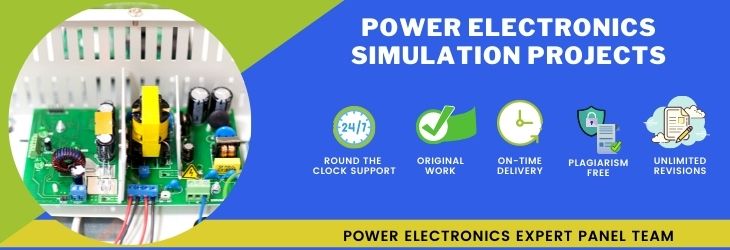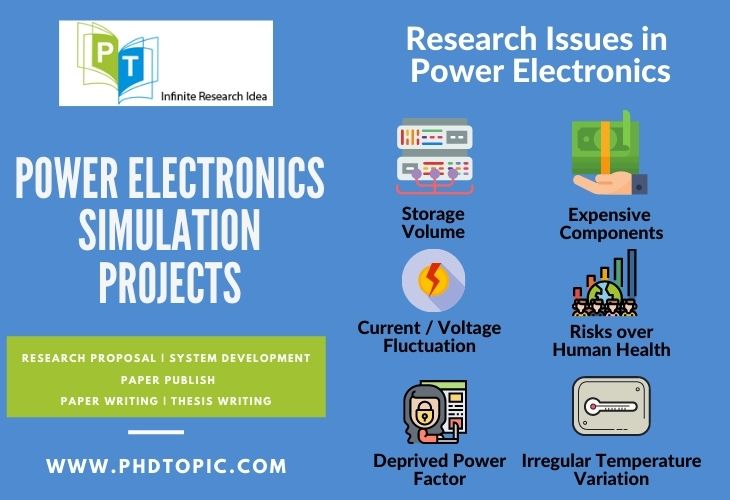Generally, power electronics (PE) are subjected to the handling of power control and power converters in data communication. Also, it is considered to be the baseline for future energy and power systems. It will provide appropriate applications and distributed energy resources (DER) for active energy networks. On holding hands with DERs, power electronics provide different control schemes for various energy resources/systems. Further, it also enhances the efficiency of the system.
From this article, you can study recent research areas, technologies, challenges, topics, and development tools for Power Electronics Simulation Projects!!!
What is Power Electronic Simulation?
The implementation of power electronics systems in the direct real world is a challenging task. So, everyone prefers to use the simulation method to analyze system performance. And, simulation is performed through some enriched simulation tool which is capable enough to crack the challenging issues and to create more innovations.
Moreover, power electronics is also one of the significant branches of electrical engineering. It helps to design electronic interfaces with power semiconductor devices for power control and conversion. Fundamentally, the power electronics system collects uncontrolled DC and AC from input sources and passes over them to power converters to produce a load of controlled DC and AC using controllers (sensors). In this, the power converter act as the core of the power electronic system. Next, we can see about applications of power electronics. Because of scientific advancements, the imprints of power electronics are found in many real-time industrial and personal applications. Here, we have given only significant applications that are popularly recognized for power electronics projects. Similarly, we also give our support on developing a following and other real-world scenarios

Power Electronics Applications
- Smart Transportation
- Vehicle-to-Vehicle
- Vehicle-to-Infrastructure
- Vehicle-to-Everything
- Business Applications
- Smart Manufacturing in Industrial Sector
- Telecommunication
- Smart Home Appliance Interface
- Mass Electrical Energy Generation and Transmission
- Power Plant / Station
Generally, the power-rating of these kinds of applications are expected to have tens of 100 Watts (for office PCs / other devices), less than 1 Watt (for portable devices), hundreds of Mega Watts (for HVDC of DC distribution model), and KiloWatts to Mega Watts (for drives). Our developers are precise in assisting you to design and build power electronic applications and systems with appropriate readings.
Outline of Power Electronics
Now, we can see the summary about power electronics simulation projects. As mentioned earlier, power electronics is a study, design, development, and of power/control/energy/converters systems. It uses switching-based power semiconductors to control and convert electrical energy in another form. These switch-mode power electronics devices help you to achieve 98-99% performance. Further, these devices allow designing circuits and supportive entities where the entities are capable to decide to control switches for accomplishing the best result. In this, one can use feedback and firing circuits.
Due to the incredible requirements of power electronics in a real-world scenario, this field is vastly approaching by active scholars and final year students to begin their research careers. Most important, this wide-ranging platform has several electrifying research areas to provide tremendous exploration opportunities to research interested people. Here, we have given you few important research areas of power electronics/circuits.
What are the research areas in Power Electronic Circuits?
- Energy-Aware Smart Inverters
- Power Storage Devices
- Smart Charging of Electric Vehicle
- High-Power Density Converters
- Robust Power Converters for Renewable Sources
- Power Electronics for Microgrids and Smart Grids
- Integration of Distributed Energy Resource
- Efficient Power Electronic Applications
- Power Converters based on Fault-Ride Through Improvement
- Power Control System for Offshore Wind Energy
In addition, our research team has given you some key technologies of power electronics. These technologies are composed of several advanced characteristics to achieve reliable, secure, and fast system performance. And, these growing technologies are currently under the creation of a strong basement for future generation trends and developments. Moreover, we have also extended our helping hands in other hybrid technologies also to elevate our power electronics simulation projects to the next level
Emerging Technologies in Power Electronics
- Switching Engines and Control
- Green Renewable Energy Model
- OFDM-based 5G Communication
- Sensor based Power Measurement
- Power Transfer in Mobile System
- Cybersecurity over Electronic Devices
- Harmonic Stability Evaluation in Power System
- Microgrid-based Hybrid AC / DC Communication
- High-voltage Direct Current Distribution
- Advanced Control System for AC / DC Microgrid
Next, we can see the technical problems that incorporate with power electronics. These problems are considered threats to power electronics system performance. Basically, these problems limit the efficiency of the system in several aspects like power usage, resource allocation, control, storage, etc. Our research team has collected numerous appropriate research solutions to solve these and other major problems. And, our solutions are always guaranteed to achieve the expected outcome at any level of problem complexity.
Research Issues in Power Electronics
- Storage Volume
- Expensive Components
- Current / Voltage Fluctuation
- Risks over Human Health
- Deprived Power Factor
- Irregular Temperature Variation (due to Storm / Rain)
Moreover, our research team also shared with you about latest ongoing research topics for innovative power electronics simulation projects. To provide you with extra-ordinary topics in default, we usually conduct a frequent study on recent research directions of power electronics. This helps us to keep ourselves update on advanced research areas to collect up-to-date research power electronics project ideas and topics. Beyond this set of topics, we also assist you in numerous creative project topics in the field of power electronics.
Latest Interesting Power Electronics Simulation Projects [Research Topics]
- Forecasting of Damaged Signal
- Assessment of Power System Lifespan
- Management of Heavy Electricity Demand
- Improved Capability for Energy Preservation
- Carbon-di-oxide Discharge Control
- Control and Impact of Heating / Cooling Systems
- Fault Tolerance in Large-volume Electricity Production
In addition, we have given you the basic requirements of the power electronics project for simulation and development. Beyond these requirements, we suggest add-on modules based on your project needs. Let’s have a quick look over the prerequisite of power electronics followed by their simulation process.
Power Electronics Simulation Requirements
- Fundamentals Mathematics and Concepts of second order system control
- Passive entities responsibilities
- Physics-oriented working principles of devices
- Criteria to select power device
Design and Simulate Model
- Construct the scenario with environmental settings
- Design and Develop the constructed model
- Execute and Assess the developed model
What is Modelling and Simulation?
In general, modeling is a practice of designing and analyzing power electronics systems based on mathematical operations and matrices. Also, it helps to identify the run-time changing characteristics of the systems using a set of system parameters in electrical engineering. The main role of modelling is to regenerate the real performance of the system which is addressed as simulation. So, both the modelling and simulation are interconnected terminologies. These two techniques are involved in the process of developing the model (i.e., proposed project) and examine the actual action and efficiency of the system in different scenarios.

Particularly, simulation is the process of conducting experiments using mathematical and logical models to signify the dynamic variation and behaviour of the system. And, this performance can be considered by a combo of algebraic and differential equations. Further, we have also given you the formulation of the system simulation below.
- Monitor physical system
- Determine the mathematical model to represent the system observation
- Forecast the model properties or system behavior
- Validate and evaluate developed model/system
Once you confirm your project topic, handpicked problem, and solving the solution, the next step is to decide suitable code development tool. Generally, the power electronics simulation projects are supported in several simulators. The main task is to select the best-fitting tool for achieving desired system performance and outcome. To select an optimal tool, one can analyze and compare supportive features, libraries, toolboxes, and modules of simulation tools that suit the project requirements.
Power Electronics Simulation Tools
Simulink
- Introduce Genetic-based Fuzzy Logic (GA-FL) controller for controlling system frequency in multi-source interlinked power system
- Further, it includes FL, GA-assisted PID controller, traditional PID
- Power system controls reheated thermal, PV unit and thermal
- Every controller monitors the tie-line power and frequency variation throughout the process
- In overall, well-suited to design and simulate both controller and systems
PLECS
- Provide ultra-speed power electronics virtualization
- Used to integrate with MATLAB/Simulink and develop multi-tasking models
- Comprises blockset (file block), PID controller (continuous /discrete), power modules (3-level half bridge in T-type), etc.
- Enable to model circuit for control prototyping and HIL testing
- I/O channels – 64 digital and 32 analog
- CPU – 1 GHz dual core
- Simple to create grid-connected modular for multiple level DC-DC converters with 4 RT boxes (connected by ultra-speed connection)
- For every phase of MMC – 10 half-bridges
- 4th box – simulates grid and passive filters
PSIM
- Enable to build and simulate speed control circuits of DC engines
- Works based on Resistance and SCDCM functions (like armature voltage control)
- SCDCM – if armature voltage maximizes, then the speed of the engine also maximizes and vice-versa
- Resistance – if field resistance maximizes, then the speed also maximizes and vice-versa
- And in feedback SCDCM function, one block has engine’s speed and other block has engine’s reference speed
PSPICE
- Used to construct and develop electronic circuits and systems
- Main objective is to forecast and analyse circuits behaviour (analog and digital)
- For instance: Develop schemes for load shedding for CEP systems
- In this, it drops CEP operative’s internal state part for managing delay bound
- For estimating dropped one, we can detect the patterns and forecast utility of partial matches by Markov reward and Markov chain techniques
Overall, we help you to develop and simulate novel power electronics simulation projects. And, we ensure you that our proposed techniques and algorithms for your project will definitely reach your expected experimental outcomes in every aspect. Further, we also support you in preparing a well-organized manuscript for your handpicked project. So, interact with our team to satisfy your research ambitions.
